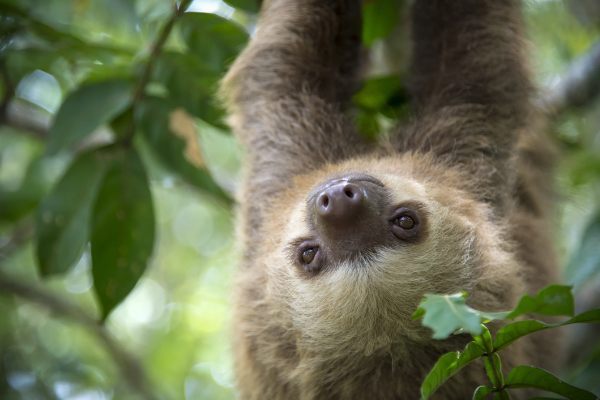Sloths are admired for their laidback lifestyles, which involves hanging out in the trees and doing very little else. Named after one of the seven deadly sins, these idle animals dwell in the tropical rainforests of Central and South America, drawn to the warm, humid climate that they find in the canopies. And while true that the sleepy sloth spends a lot of time above ground, there’s method in its (lack of) movement. Discover that there’s more to these creatures than meets the eye with the top eight sloth facts…
1. Sloth species
2. Tree-huggers
3. Toilet tales
4. Fantastic fur
5. Measured metabolism
6. Aquatic ability
7. Avocado advocates
8. Variable vision
1.
Sloth species
Our sluggish friends can be split up into two families: three-toed and two-toed sloths. Out of four three-toed sloth species, the brown-throated sloth is the most common, while there are just two species of two-toed sloths. The main difference between them? Well, the clue’s in their names. Counting toes aside, you can tell the sloth species apart from their size: two-toed sloths are slightly larger than their counterparts. You’re also more likely to see the two-toed variety in the wild, as sadly the pygmy three-toed sloth is critically endangered, and the maned three-toed sloth is on the vulnerable list.
2.
Tree-huggers
Contrary to popular opinion, sloths only actually snooze for eight to ten hours per day. A sloth fact which may come as a surprise is that their sleeping habits are not dissimilar to ours (if we swapped beds for branches). Who knew sloths were so relatable? It’s true, however, that the mammals do spend most of their lives suspended in the trees. They spend as much as 15-20 hours of every day hanging motionless or moving slowly between branches. Sloths grip on to branches with their long, curved claws, using their considerable strength – over three times stronger than the average human – to hang without exerting energy.

3.
Toilet tales
For sloths, everything from eating to giving birth happens among the leaves. In fact, sloths are so fond of trees, that the only time they will descend from the branches is to defecate. A curious habit that has been baffling scientists for years, sloths journey to the forest floor to do the deed once a week. Given that they’re defenceless while on the ground, sloths put their lives at risk every time nature calls. It’s no surprise they prefer to stay up high.
4.
Fantastic fur
Say what you want about a sloth’s appearance, but there’s no denying they’ve got a good head (and body) of hair. And did you know that this fur hosts an entire world of its own? Owing to the green algae which thrives there, sloth fur houses a variety of insects, microbes and fungi – some of which are found nowhere else in the world. While we could definitely think of nicer places to call home, we can still appreciate this sloth fact. Sloths’ green fur even helps with survival, camouflaging the creature from the preying eyes of predators.
5.
Measured metabolism
Boasting the slowest metabolic rate of any animal, it can take a sloth up to 30 days to digest a single leaf. As folivores, the sedate sloth’s diet consists of leaves, fruits and sap from trees, which is all digested in their special multi-chambered stomach. Sloths’ slow metabolism allows them to conserve energy and survive on scarce amounts of food, but also makes them more susceptible to shifting environmental temperatures.

6.
Aquatic ability
Here’s another surprising sloth fact: did you know they’re fantastic swimmers, moving three times faster in water than on the ground? In contrast to the difficulty of the tree-dwellers’ lives on the ground, sloths have a natural buoyancy and can hold their breath for up to 40 minutes underwater. Dropping from canopies into bodies of water below, sloths can skilfully swim large distances when on the search for new partners, or new canopies to call home.
7.
Avocado advocates
Next time you tuck into the creamy flesh of an avocado, think of the sloth and its ancestors. We have the extinct giant ground sloth to thank for our favourite brunch component. These ancient creatures were the only mammals with stomachs large enough to be able to swallow an avocado seed whole. These feasting habits dispersed avocados seeds far and wide, bringing us all the delicious fruit we know today.
8.
Variable vision
Our final sloth fact relates to the mammal’s vision. As colourblind creatures, sloths struggle to see in dim light, and can’t see at all in bright daylight. Confined to the branches, this daylight blindness doesn’t seem to hinder their survival. Luckily, sloths have a wonderful sense of smell and spatial memory to compensate. Given that they’ve existed for over 65 million years, they seem to be faring just fine without 20/20 vision.
Written by Hannah Whitehall













